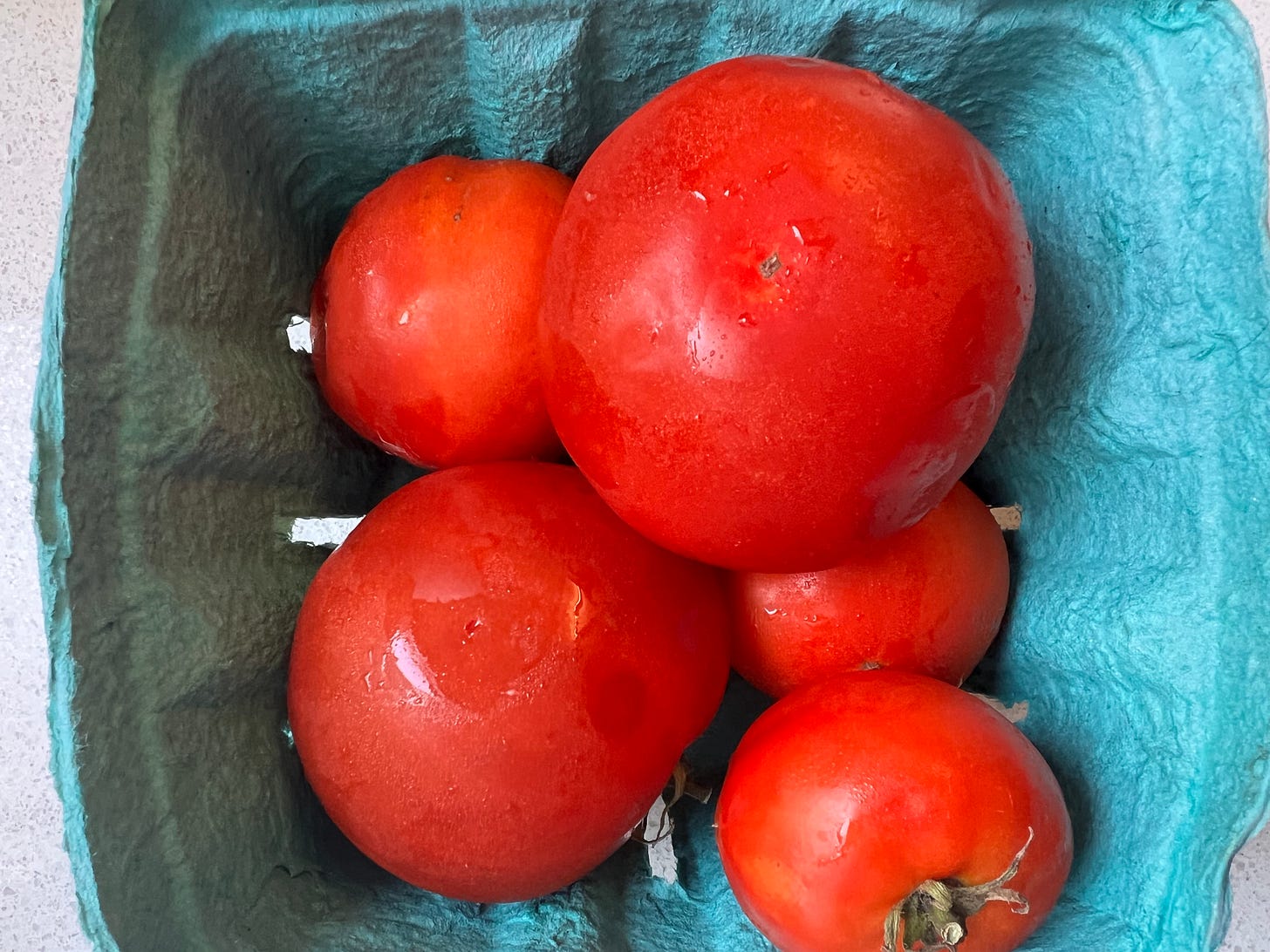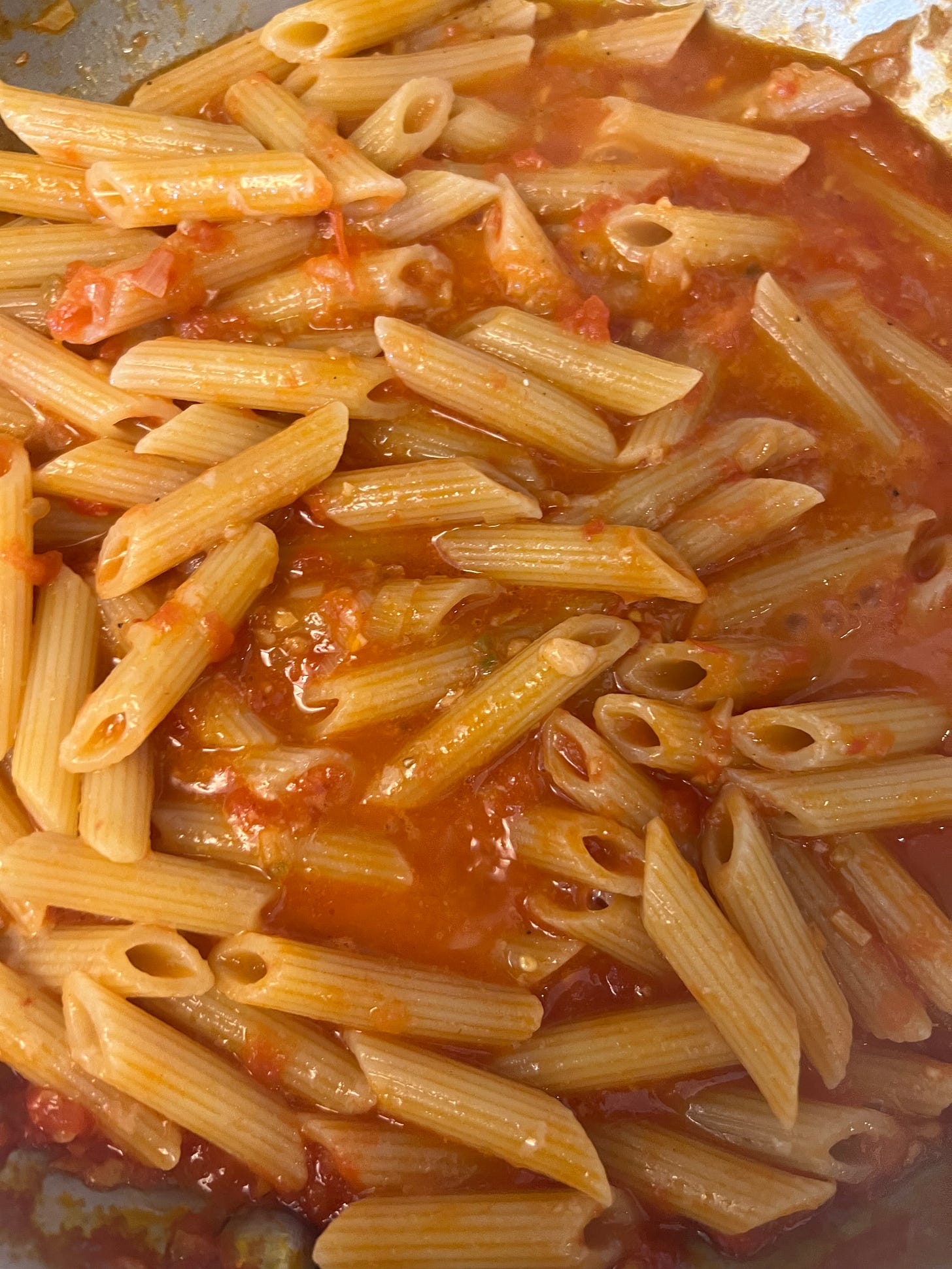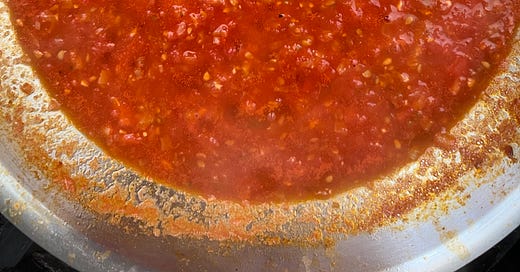Issue #116: Tomato Time, Again! A Fresh Tomato Sauce
Israeli Food Tech, a Sauce to Make with All Those Ripe Tomatoes You Can't Eat, and an Etymological Correction for Last Week's Zucchini
This week on my What’s Burning podcast I talk with Alon Turkaspa, the Agriculture and Food Technology Lead for the Tel Aviv based nonprofit Start-Up Nation Central. You might not be aware that Israel is one of the leading incubators for technology start-ups. Some people even refer to it as Silicon Wadi, a play on California’s Silicon Valley. (Wadi is Arabic for “valley” or “riverbed.”). Start-Up Nation Central is dedicated to nurturing the tech start-up ecosystem in Israel and ensuring that the innovations and solutions from companies there can be applied wherever they are needed around the world. My conversation with Alon explores the food- and ag-tech sector of this fascinating industry. Have a listen.
Here in the Northeast it’s tomato time. These days, whenever we go to dinner at friends’ houses in the Finger Lakes, we inevitably leave with a pile of tomatoes (usually some zucchini and peppers, too). Everyone has more tomatoes than they can eat or handle right now. Even our own tomato plants on our terrace in Manhattan have been extremely productive this year.

I love tomatoes. But there are only so many tomato sandwiches or tomato salads one can eat. (I’m almost at that point.) One of my favorite uses for excess tomatoes is a quick, fresh tomato sauce for pasta. Made with ripe, local, in-season tomatoes, almost nothing compares.

Now, I know that food snobs will suggest you shouldn’t make a tomato sauce from beefsteaks or other slicers, such as the beloved Jersey tomatoes that color the Union Square Greenmarket right now. They are said to be too watery and to lack enough concentrated flavor for sauce. I’m here to tell you otherwise. Sure, a certified San Marzano tomato from the volcanic soil of southern Italy is a special thing, with a flavor and texture all its own. And Roma, plum or other “paste” tomatoes, as those destined for sauce are known, have been developed to produce a rich, saucy taste and texture when cooked.
But I have good success using big, ripe, juicy tomatoes for sauce, too.
A few key things. The skin on tomatoes is fine when they are sliced and eaten raw, but when cooked it becomes a textural annoyance. You can peel your tomatoes using the classic technique of scoring them with an “x,” blanching them for a minute in boiling water, and dropping them in ice water so that the skin slips off. But I avoid all this production by simply cutting them in half and grating them on a box grater. This technique separates the pulp from the skin and also eliminates the need to dice or chop. I can’t take any credit for it. It’s used in every Spanish home to make pan tomate (see Issue #65) and probably a few Italian homes, as well.
A fresh tomato sauce should be quick and easy. This isn’t a Sunday gravy that will cook for hours. Forget the dried oregano and garlic powder. You want to preserve the taste and texture of the fresh tomato. Like many great Italian dishes, you should be able to make a fresh tomato sauce in the time it takes to boil water and cook pasta. To add a little zing, I add tiny amount of fresh garlic and a pinch of hot pepper, fresh or dried (they are usually in season around the same time).
Finally, the tomato flavor benefits from umami, which tomatoes already have naturally. But I like to bump it up a bit, adding a little tomato paste, or even some dashi or a touch of miso or soy sauce. Besides the paste, none of this would be considered “authentic,” whatever that means, but trust me it brings out the flavor.
RECIPE: Quick, Fresh Tomato Sauce
(Makes about 2 cups sauce, enough for 2 or 3 portions of pasta)
2 or 3 tablespoons extra-virgin olive oil
1 small piece (1 ounce) onion, finely chopped
1 small clove garlic, minced
1 small hot pepper (in season), minced, or pinch red pepper flakes (optional)
1 to 1 ½ pounds large, ripe slicing tomatoes, cut in half horizontally
1 teaspoon double-concentrated tomato paste or red miso or 1/2 teaspoon soy sauce
¼ cup dashi, chicken stock, white wine, vegetable stock, or water
Pinch salt
Freshly ground black pepper
In a large sauté pan, heat the olive oil over medium heat. Add the chopped onion and cook, stirring, for a minute or two until it begins to soften. Add the garlic and hot pepper, if using, and sautée until fragrant. Do not let the onions or garlic burn or even brown much, as this will impart a bitter flavor. Lower the heat.
Using the large holes of a box grater held over the pan, place the cut side of a tomato half against the grater and press with your fingers or palms while moving back and forth to remove the pulp the from the skin. You should be able to get just about all of the pulp through the grater. The skin will shield you fingertips from the grater’s holes. Repeat with the remaining tomatoes until the all the pulp is in the pan
Turn the heat back up to medium to simmer. Add the tomato paste or soy sauce and dashi or other liquid and continue simmering until the sauce begins to thicken just a bit. Season with salt and pepper, to taste. If the sauce thickens too much, add some pasta cooking water to thin it down and keep simmering.
To serve, toss some hot, short, cooked pasta, such as penne, with the sauce, a drizzle of good olive oil, and some freshly grated parmesan. Garnish with fresh basil. Mmm.

A Note About Storing Tomatoes
While it is best to store tomatoes at room temperature, they will continue to ripen and eventually over ripen and mold. When they are just about ready to burst, I move them to the fridge, where they will keep a week or two longer, maybe more. Chilled tomatoes are easier to grate as the flesh is firmer than when at room temperature.
A Concia Correction
I awoke this morning to find an entire Substack devoted to correcting an etymological side note in last week’s Kitchen Sense Issue #115 about concia di zucchine, or Roman Jewish marinated zucchini. I love the Internet, truly. Writing as a guest in Cheryl Ossola’s Italicus, Giorgia Meschini explores about a million possible origins and antecedents of the word concia, none of which have to do with laundry, which I read from someone who heard it from someone else and mentioned in my post. In fact, concia di zucchini has always likely simply meant “seasoned zucchini” in dialect. But it turns out concia and related words can also mean so much more. It’s a fun and fascinating read. And it reminds me while I also love Italian. I wonder what Giorgia will have to say about today’s sauce.








Umm, indeed ... made for a delicious and easy dinner this evening!
Cheers,
Marcia & Jack
Thank you for this, Mitchell. You led me to a fascinating site, Cheryl Ossola's Italicus, to which I just subscribed.